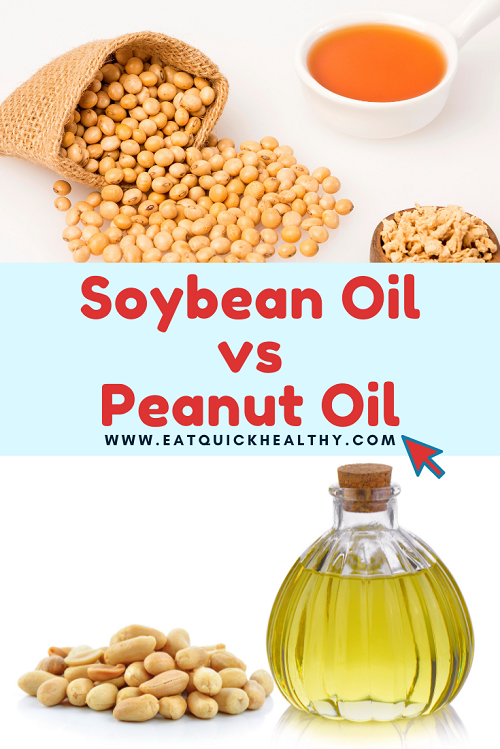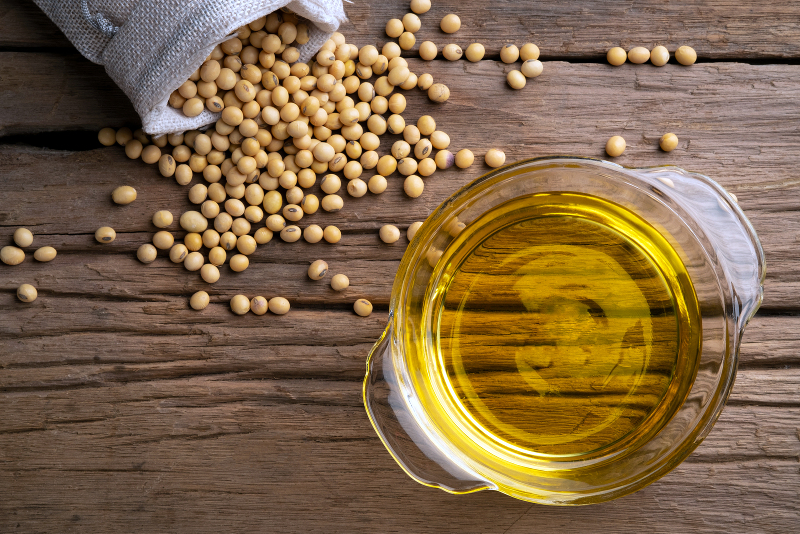Are you wondering which cooking oil to buy when comparing soybean oil and peanut oil? Well, you’ve clicked onto the right blog!
These oils are widely used and for good reason. Below, we’ll go over exactly why that is. And once you’ve read through the whole article, you’ll know exactly which cooking oil will serve your needs the best.
This comprehensive breakdown will teach you what soybean oil and peanut oil are. We’ll also go over their health benefits, as well as their respective compositions, smoke points, other uses and more. There’s a ton of things for you to know about soybean oil vs peanut oil, so keep reading to find out!

What Is Soybean Oil?
Soybean oil is a very popular vegetable-based cooking oil. Soybean seeds are extracted from a plant and then utilized to make the oil, which can be used for a variety of different things in the kitchen including roasting, baking and frying.
Interestingly, Soybean oil is the second most-consumed vegetable oil behind palm oil and just ahead of sunflower oil. It’s also an ingredient in margarine.

Is Soybean Oil Healthy?
In general, Soybean oil is known as a cooking oil with some health benefits. It’s mostly made up of polyunsaturated fatty acids, which can help prevent heart disease and maintain a healthy heart all-around.
You’ll also get a dose of vitamin K when you consume soybean oil, and that can lead to better bone health. Further, there is omega-3 in the cooking oil, which has a bevvy of health benefits if eaten, including reducing inflammation.
However, there are also cons associated with consuming soybean oil. The biggest one is that it’s very rich in omega-6, a fatty acid that has been linked to several ailments, including increased blood sugar and body fat.
Benefits Of Soybean Oil
As mentioned above, there are several health benefits associated with soybean oil, including reducing inflammation, improving skin and bone health, and mitigating heart issues.
Also, soybean oil is a very versatile cooking oil, so it won’t just be sitting around in your cupboard waiting for you to do your monthly baking. It can be used for frying, sauteing and roasting as well. And it’s a great oil to use for salads!
What Is Peanut Oil?
Peanut Oil is another well-known cooking oil with a high smoke point. Also known as arachis oil or groundnut oil, peanut oil is vegetable-based and made with, you guessed it, peanuts. The edible seeds of a peanut plant are taken and used to make this oil, which is widely viewed as a great deep-frying oil alternative.
You’ll find several types of peanut oil at the store, including cold-press peanut oil, refined peanut oil and gourmet peanut oil. Some types of peanut oil have a bit of a nutty taste to it, depending on what kind you buy and how it was made.
And peanut oil isn’t just used in the kitchen. Some have declared that it has medicinal benefits, including aiding in joint pain, constipation and heart disease.

Is Peanut Oil Healthy?
There are positives and negatives when it comes to the healthiness of peanut oil. It’s rich in vitamin E, and when consumed, your body will be more protected from free radical damage. Vitamin E is also essential to combat things like high blood sugar levels if you’re a diabetic, as well as potential heart problems. You’ll also find omega-3 in this oil, which is an important fatty acid to consume for maintaining a healthy body.
On the other hand, peanut oil has omega-6, which has been linked to several negative health consequences, like inflammation, obesity and cancer.
Benefits Of Peanut Oil
There are several benefits to peanut oil, including the health benefits listed above, especially the high dose of vitamin E. Vitamin E is a great tool to use to help prevent ageing skin like reducing wrinkles and blemishes. It’s also a very convenient oil to use for deep frying if you purchase the refined version.
Click here to learn how to freeze peanut oil.
Soybean Oil Vs Peanut Oil
Now here comes the comparison between soybean oil and peanut oil. In this section, you’ll read a thorough breakdown of the differences and similarities between the two, specifically in composition, smoke point, deep-frying capabilities and other uses.
Oil Composition
Soybean oil is composed of around 60% polyunsaturated fat, 25% monounsaturated fat and 15% fat. And nearly half of peanut oil is monounsaturated fat, 32% is polyunsaturated fat and 17% is saturated fat.
Both polyunsaturated and monounsaturated fats are known as healthy fats, and soybean oil and peanut oil are mostly comprised of them. Peanut oil has a slightly higher level of saturated fat compared to soybean oil. Consuming too much saturated fat can raise your LDL cholesterol level, which has been linked to strokes and heart disease.
Peanut Oil Vs Soybean Oil Smoke Point
Both peanut oil and soybean oil are known for their high smoke points.
Peanut oil is commonly used by restaurants for deep frying because of this. Refined peanut oil can handle temperatures of around 450 degrees Fahrenheit, or 232 degrees Celsius, before burning.
On the other end, Soybean oil’s smoke point is around 450 degrees Fahrenheit as well. So, because of their high burning points, both oils are great for high-temperature cooking, like sauteing and baking.
Soybean Oil Vs Peanut Oil For Deep Frying
As we just mentioned, both soybean oil and peanut oil have high smoke points, and to deep fry, that’s exactly what you need. Peanut oil is a very popular deep frying oil because it doesn’t absorb the taste of the food that’s being cooked in it. Refined peanut oil is also generally aromaless, unlike other versions of peanut oil.
Soybean oil has roughly the same burning point as peanut oil, so it can handle deep frying just the same. Also, it’s a neutral-tasting oil, so it won’t alter the deliciousness of your meal.
If you’re cooking for a group of people and you don’t know if they’re allergic to peanuts, it may be safer to choose soybean oil rather than peanut oil, even though refined peanut oil generally won’t spark up an allergic reaction.
Other Uses
Like we’ve mentioned a few times, both peanut oil and soybean oil are known for other things besides cooking. Although there is insufficient evidence to back these claims up, there are a lot of anecdotal accounts of peanut oil boasting medicinal benefits, including combating constipation and joint pain.
It’s also great for the skin because of its high composition of vitamin E.
Soybean oil also carries with it medicinal uses, like lowering inflammation and the threat of heart disease, as well as elevating bone and skin health. The oil also has a multitude of different uses inside the kitchen, like being a great topper for a salad.
Can You Make A Soybean Peanut Oil Blend?
Both soybean oil and peanut oil are vegetable-based oils with a similar smoke point, so that means that technically yes, you can make a soybean peanut oil blend. An important rule of thumb, however, is that it’s a better practice to only use one type of oil, especially if you don’t know their individual cooking properties like their burning point.
However, sometimes you are trying to make dinner and you realize that you are running low on cooking oil and mixing two is the only option besides making an inconvenient trip to the supermarket. If that’s the case, you can mix these two together.
Other Things To Consider
If you’re wondering about the price of soybean oil compared to peanut oil, know that the former is cheaper than the latter. So if you want to save some cash, soybean oil may be a better option than peanut oil.
You can see the price differences by
Conclusion
We hope that you’ve learned everything you need to know about the differences between soybean oil and peanut oil. With this new knowledge, you should be able to determine which oil is the best.
Remember, it’s up to you to decide which one comes out on top, and it mostly depends on your need for the oil.
So, consider everything in this blog and head over to the grocery store to pick up a bottle of one of these oils. Or even better, pick up one of each!
Want to learn about other types of oils? Read our peanut oil vs canola oil comparison here and peanut oil vs sunflower oil here. You can find all out peanut product guides here.



Comments are closed.